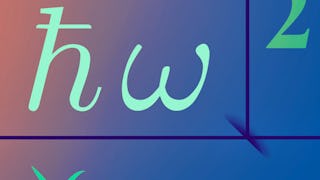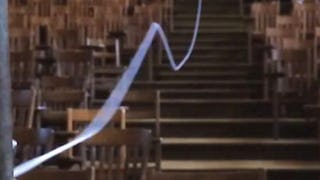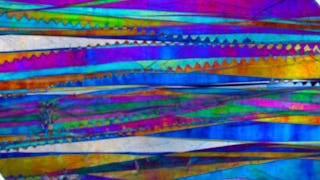Ce cours vous donne accès aux outils et concepts de base pour comprendre les articles de recherche et les livres sur l'optique quantique moderne. Vous apprendrez ce qu'est la quantification de la lumière, le formalisme permettant de décrire les états quantiques de la lumière sans aucun analogue classique, et les observables permettant de démontrer les propriétés quantiques typiques de ces états. Ces outils seront appliqués au cas emblématique d'un paquet d'ondes à un photon, qui se comporte à la fois comme une particule et comme une onde. La dualité onde-particule est un grand mystère quantique selon les mots de Richard Feynman. Vous serez en mesure d'apprécier pleinement les expériences réelles démontrant la dualité onde-particule pour un photon unique, et les applications aux technologies quantiques basées sur des sources de photons uniques, qui sont maintenant disponibles dans le commerce. Les outils présentés dans ce cours seront largement utilisés dans notre second cours d'optique quantique, qui présentera des sujets plus avancés tels que l'intrication, l'interaction de la lumière quantifiée avec la matière, la lumière comprimée, etc...


(337 avis)
Compétences que vous acquerrez
- Catégorie : Recherche en laboratoire
- Catégorie : Mathématiques appliquées
- Catégorie : Physique
- Catégorie : Expérimentation
- Catégorie : Cryptographie
- Catégorie : Technologies émergentes
- Catégorie : Instruments d'ingénierie, scientifiques et techniques
- Catégorie : électromagnétisme
Détails à connaître

Ajouter à votre profil LinkedIn
26 devoirs
Découvrez comment les employés des entreprises prestigieuses maîtrisent des compétences recherchées

Il y a 7 modules dans ce cours
Dans cette première leçon, vous découvrirez ce qu'est la quantification canonique, l'appliquerez à la quantification d'un seul mode du champ électromagnétique et constaterez qu'il se comporte comme un oscillateur harmonique quantique. La notion de photon émergera alors naturellement, ainsi que la notion étrange mais fondamentale de fluctuations du vide.
Inclus
13 vidéos3 lectures10 devoirs
Dans cette leçon, vous découvrirez comment le formalisme de l'optique quantique conduit au comportement d'une particule d'un paquet d'ondes d'un photon. Pour cela, vous devrez apprendre les expressions d'optique quantique des signaux de photodétection simples et conjoints. Une comparaison avec les expressions semi-classiques illustrera la nécessité de l'optique quantique.
Inclus
7 vidéos2 lectures5 devoirs
Dans cette leçon, vous aborderez la question fascinante de l'interférence d'un photon unique avec lui-même, en calculant la figure d'interférence d'un photon unique lancé dans un interféromètre de Mach-Zehnder. Pour ce faire, vous apprendrez d'abord comment traiter un séparateur de faisceau en optique quantique, un outil très important que vous devez connaître. Vous apprendrez également que lorsque vous souhaitez décrire un instrument optique en optique quantique, il est très utile de maîtriser sa description en optique classique. Cette leçon est l'occasion de réfléchir au concept mystérieux de dualité onde-particule, et à la puissance du formalisme quantique, qui permet de traiter de manière cohérente deux comportements apparemment contradictoires.
Inclus
6 vidéos3 lectures4 devoirs
Dans le monde réel, il n'y a rien de tel qu'un rayonnement purement monochromatique. Une description correcte du rayonnement implique nécessairement plusieurs modes. Dans cette leçon, vous apprendrez comment la quantification canonique peut être facilement généralisée au cas de plusieurs modes, et comment diverses observables ou quantités importantes introduites dans le cas monomode sont exprimées dans le cas multimode. Au-delà du formalisme que vous devez apprendre pour pouvoir lire des articles et des livres décrivant des situations réelles, vous rencontrerez dans cette leçon quelques caractéristiques intrigantes du formalisme quantique : premièrement, la taille incroyablement grande de l'espace des états, qui est la raison de la puissance potentielle illimitée de l'information quantique ; deuxièmement, la question des infinités, un problème qui a été résolu par la procédure générale de renormalisation. Notez que des lectures optionnelles sont proposées comme ressources pour certains cours.
Inclus
8 vidéos3 lectures2 devoirs
Les sources de photons uniques sont des composants importants de l'optique quantique, tant dans les laboratoires de recherche que dans les technologies quantiques appliquées. La leçon de cette semaine présentera les différents types de sources de photons uniques disponibles aujourd'hui, des sources de photons uniques annoncées aux sources de photons uniques à la demande. Vous apprendrez à utiliser le formalisme multimode présenté dans une leçon précédente pour décrire les paquets d'ondes à un photon, en particulier dans le cas d'un photon émis spontanément. Vous commencerez par la présentation d'un outil théorique très utilisé en optique quantique, le formalisme de Heisenberg. Il vous permettra de découvrir la formule exprimant la probabilité d'une double détection à deux instants différents. Vous apprendrez également quelques "trucs du métier" sur les transformées de Fourier.
Inclus
7 vidéos2 lectures1 devoir
Vous êtes maintenant prêt à développer la description d'une expérience réelle, qui a été la première à révéler directement la double nature - onde et particule - d'un paquet d'ondes à photon unique. Vous serez non seulement en mesure de décrire, grâce au formalisme que vous avez appris, les comportements de type particulaire et ondulatoire, mais vous verrez également comment prendre en compte les caractéristiques d'une expérience réelle, qui n'est jamais parfaite. Enfin, nous aurons l'occasion de réfléchir aux notions de dualité onde-particule et de complémentarité, qui ne doivent pas être confondues, et à la déclaration de Feynman, qui a qualifié la dualité onde-particule de "grand mystère quantique". J'essaierai de vous convaincre que lorsque l'on identifie un comportement mystérieux, il ne faut pas se plaindre, mais plutôt explorer la possibilité que quelque chose de nouveau et d'intéressant puisse émerger de ce mystère.
Inclus
8 vidéos2 lectures2 devoirs
Dans cette leçon, vous découvrirez deux technologies quantiques basées sur des sources à un photon. Les technologies quantiques permettent d'atteindre un objectif d'une manière qualitativement différente d'une technologie classique visant le même objectif. Par exemple, la cryptographie quantique est insensible aux progrès de la puissance des ordinateurs, alors que de nombreuses méthodes de cryptographie classique peuvent en principe être cassées lorsque nous disposons d'ordinateurs plus puissants. De même, les générateurs quantiques de nombres aléatoires produisent de vrais nombres aléatoires, alors que les générateurs classiques de nombres aléatoires ne produisent que des nombres pseudo-aléatoires, qui peuvent être devinés par quelqu'un d'autre que l'utilisateur. Cette leçon est également l'occasion d'apprendre deux concepts importants de l'information quantique : (i) les qubits basés sur la polarisation des photons ; (ii) le célèbre théorème de non-clonage, à la base de la sécurité de la cryptographie quantique.
Inclus
7 vidéos1 lecture2 devoirs
Instructeurs


Offert par
En savoir plus sur Physique et astronomie
 Statut : Prévisualisation
Statut : PrévisualisationÉcole Polytechnique
 Statut : Essai gratuit
Statut : Essai gratuitRice University
 Statut : Essai gratuit
Statut : Essai gratuitRice University
 Statut : Essai gratuit
Statut : Essai gratuitRice University
Pour quelles raisons les étudiants sur Coursera nous choisissent-ils pour leur carrière ?




Avis des étudiants
337 avis
- 5 stars
88,42 %
- 4 stars
9,49 %
- 3 stars
0,89 %
- 2 stars
0,59 %
- 1 star
0,59 %
Affichage de 3 sur 337
Révisé le 4 déc. 2019
Really good course, but you need to have a strong background in quantum mechanics in order to understand the lessons. Professor Aspect clearly explains the topics
Révisé le 9 mars 2018
There should be more resources to study like some lecture notes. Besides that, the overall level is very good.
Révisé le 13 avr. 2025
Not very easy, but really interesting. Thank you so much to the professors for taking the time to put it together !

Ouvrez de nouvelles portes avec Coursera Plus
Accès illimité à 10,000+ cours de niveau international, projets pratiques et programmes de certification prêts à l'emploi - tous inclus dans votre abonnement.
Faites progresser votre carrière avec un diplôme en ligne
Obtenez un diplôme auprès d’universités de renommée mondiale - 100 % en ligne
Rejoignez plus de 3 400 entreprises mondiales qui ont choisi Coursera pour les affaires
Améliorez les compétences de vos employés pour exceller dans l’économie numérique
Foire Aux Questions
Il n'y a pas d'obligation, mais les notions apprises dans ce cours seront nécessaires pour suivre le deuxième cours, qui présentera l'interaction entre la matière et le rayonnement quantifié, l'absorption, l'émission stimulée et l'émission spontanée de photons, la lumière comprimée, les photons intriqués, le traitement quantique de l'optique non-linéaire, et les applications aux technologies quantiques, etc...
Pour accéder aux supports de cours, aux devoirs et pour obtenir un certificat, vous devez acheter l'expérience de certificat lorsque vous vous inscrivez à un cours. Vous pouvez essayer un essai gratuit ou demander une aide financière. Le cours peut proposer l'option "Cours complet, pas de certificat". Cette option vous permet de consulter tous les supports de cours, de soumettre les évaluations requises et d'obtenir une note finale. Cela signifie également que vous ne pourrez pas acheter un certificat d'expérience.
Lorsque vous achetez un certificat, vous avez accès à tous les supports de cours, y compris les devoirs notés. Une fois le cours terminé, votre certificat électronique sera ajouté à votre page de réalisations - à partir de là, vous pouvez imprimer votre certificat ou l'ajouter à votre profil LinkedIn.
Plus de questions
Aide financière disponible,

